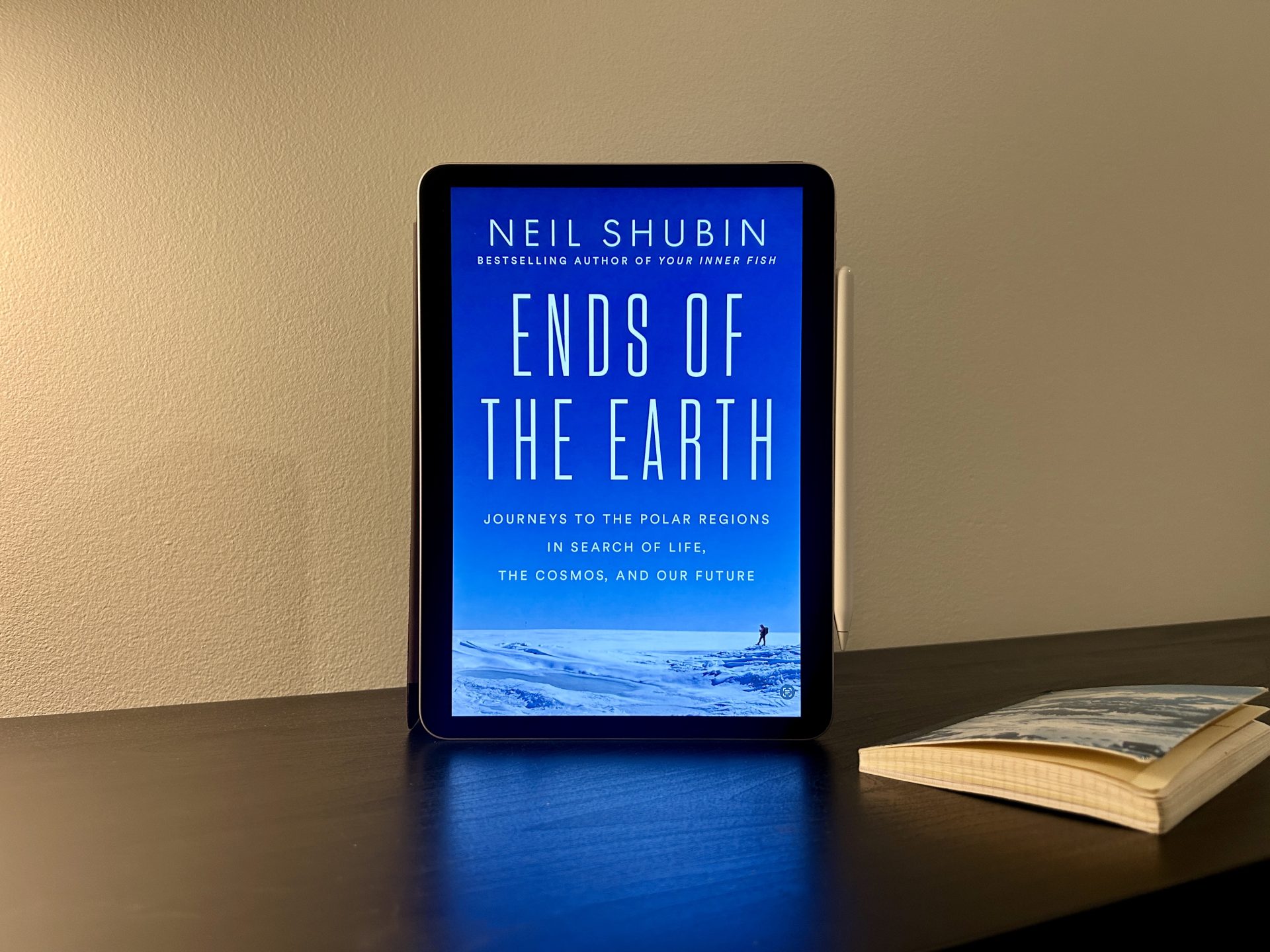The polar regions often feel like faraway places: remote, unreachable, and separate from our daily lives. Most of us will never set foot in the Arctic or Antarctica, so it’s easy to imagine they have little to do with us. But the surprising truth is even though they cover only about 8 percent of Earth’s surface, nearly 70 percent of all fresh water is locked away in their ice. These frozen landscapes may look distant on a map, but what happens there ripples across the whole planet.
That’s what makes Neil Shubin’s Ends of the Earth such a fascinating read. The book brings the poles closer, blending together science, storytelling, and breathtaking photography. Every page is an invitation to step onto the ice and see how deeply connected we are to these fragile regions.
For centuries, glaciers shaped our journeys of exploration, our great tragedies, and our discoveries. Once thought of as untouched wilderness, the poles now reveal the fingerprints of human activity. The way we live in cities and towns far from the ice is still tied, inextricably, to its future.
I found myself constantly amazed by the small details Shubin highlights. For example, did you know the Arctic has its very own tree, the tiny Arctic willow? Or that the Arctic woolly bear caterpillar can survive some of the harshest conditions on Earth? Alongside these discoveries, Shubin also shares practical advice for anyone dreaming of studying or exploring polar regions, which makes the book feel both inspiring and useful.
The highlight of this book is about change. As our climate warms, the poles are shifting at an alarming pace. Habitats are disappearing, food webs are unraveling, and species are struggling to survive. Shubin reminds us that the story of the Arctic and Antarctica isn’t isolated, what happens there directly affects us, no matter where we live.
Perhaps the most powerful insight Shubin leaves us with is this: moving ice has always shaped Earth, and humanity itself rose during a rare moment when the poles were covered in ice. Now, at the very moment we depend on that stability most, we’re also the ones changing it fastest.
Ends of the Earth reminds us the poles aren’t as far away as they seem. They’re part of our shared home.
Summary
How Glaciers Shape Life, History, and the Future of Our Planet
Ice is not only frozen water. It’s a powerful force that reshapes our world. As glaciers grow, shrink, and move, they carve out new environments where life finds surprising ways to adapt. Harsh, icy landscapes often give rise to remarkable new forms of life. Glaciers shape ecosystems and hold time itself. For thousands of years, ice has trapped objects and particles, preserving pieces of cosmic history. When that ice melts, it reveals clues about our planet and the universe. And because glaciers move faster than we might imagine, they tell us about the past and have the power to transform Earth’s future within our lifetimes.
Melting Glaciers May Release Ancient Viruses Into Today’s World
When glaciers melt, they release water and can also release ancient viruses long trapped in the ice. Scientists have found that the amount of viral spillover is directly linked to the volume of meltwater they tested. In simple terms: the more melting, the more viruses emerge. As warming continues, this raises the possibility of viruses jumping into local plants and animals, potentially reshaping ecosystems in unpredictable ways.
Antarctica: A Natural Laboratory for Studying Stardust
Our planet is constantly covered in dust, from car exhaust to the tiny fragments left behind by human activity. This makes it difficult for scientists to find cosmic dust, or “stardust,” in its purest form. But there’s one place that stands out: Antarctica. Far from cities, roads, and factories, this frozen continent is like a clean slate. Its vast, untouched ice sheet creates the perfect setting for researchers to collect and study particles that have traveled across the cosmos to reach Earth.
The Race for Arctic Resources in a Warming World
As Arctic ice retreats, vast new areas are opening up to wildlife as well as to human industries. What was once inaccessible is quickly becoming a frontier for fishing, mining, and energy exploration. According to the U.S. Geological Survey, the Arctic may hold nearly a third of the world’s undiscovered natural gas and over 10 percent of its untapped oil. On top of that, the seafloor is believed to contain lithium for batteries and rare-earth metals essential for modern technology.
This shift is an economic opportunity and a geopolitical challenge. Borders in the Arctic, once little more than lines on a map, are taking on new urgency. For small communities and entire nations alike, the disappearing ice is reshaping not only the landscape but also global politics. With resources at stake, tensions that have been quietly building for decades are starting to surface.
Author: Neil Shubin
Publication date: 4 February 2025
Number of pages: 288 pages


Leave a Reply